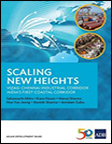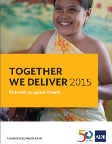Asian Development Outlook (ADO) 2018: How Technology Affects JobsDeveloping Asia is forecast to expand by 6.0% in 2018 and 5.9% in 2019. Growth in South Asia is expected to be revived after a two-year slowdown. India is expected to bounce back to 7.3% in 2018 and 7.6% in 2019 owing to the effects of tax and banking reforms and corporate deleveraging. Growth will be strong in the rest of South Asia, with a forecast of 7.0% in 2018 and 7.2% in 2019, but expansion will be affected in Bangladesh and Sri Lanka following a need to carry out revenue-enhancing fiscal reform and to strengthen economic policy. Inflation forecast in South Asia is 4.7% in 2018 and raised to 5.1% in 2019. Author: Asian Development Bank Year: 2018 Download Tags: ADB, Bangladesh, Bhutan, India, Employment, Jobs, Maldives, Myanmar, Nepal, Sri Lanka, Technology World Trade Report 2017: Trade, Technology, and JobsEconomic growth over the last 25 years has been accompanied by unprecedented economic change. Over the past two decades, many countries have experienced significant transformations in the sectoral and occupational structure of employment. This report examines how technology and trade affect employment and wages and analyzes the challenges for workers and firms in adjusting to changes in labor markets. It looks at how governments could increase the positive impact of open trade and technological trade in South Asia and around the world. Author: World Trade Organization Year: 2017 Download Tags: Trade, ICT, Employment, Global Value Chains, South Asia Climbing Higher: toward a Middle-income NepalNepal is experiencing modest growth but brisk poverty reduction. It has halved the poverty rate in just seven years and witnessed an equally significant decline in income inequality. Yet Nepal remains one of the poorest and slowest-growing economies in Asia, with per capita income falling behind its regional neighbors. The report discusses the need for comprehensive policy reform to address the country’s challenges in becoming a lower-middle-income country by 2030. The report outlines suggested reforms to facilitate greater investment and improved productivity, build new sources of growth, and deepen human capital. Author: World Bank Group Year: 2017 Download Tags: Employment, Investment, Nepal, Poverty Reduction, Trade, Transport, WB Growth Slowdowns, Middle-Income Trap, and Demographic Profile in South AsiaThis paper examines how investment in human capital is critical for innovation. Analyzing the different growth-promoting factors in South Asian economies, with a focus on demographics, and factors that can help shift middle-income countries to high-income countries, it concludes that economic transition is affected by firms’ productive advantages—ability to compete with high-skilled producers, low-wage exporters—and education-based growth, which can help advance the country's technological capacity. Author: S. P. Jayasooriya Year: 2017 Download Tags: Economics, Employment, Manufacturing, Economic Corridor, South Asia Renewable Energy Sector in Emerging Asia: Development and Policies (TIID Working Paper No. 1/2017)Rapid economic growth in emerging Asia has led to a critical increase of greenhouse gas emissions. Transitioning to renewable energy sources would help reduce emissions. However, massive investment is needed to make that transition. According to this paper, targeted policy interventions are needed to facilitate trade and investment in the renewable energy sector and create “green jobs” in the low-carbon and resource-efficient sectors. Author: Masato Abe, Candice Lea Marie Branchoux, Jaewon Kim Year: 2017 Download Tags: Bangladesh, Energy, Governance, Hydropower, Employment, India, Myanmar, Sustainability, UNESCAP  Scaling New Heights: Vizag-Chennai Industrial Corridor, India’s First Coastal CorridorThis book provides policymakers with a guide to understanding India’s economic corridor development strategy by examining its first coastal economic corridor, the East Coast Economic Corridor. It lays out the plan for its first phase, the Vizag–Chennai Industrial Corridor, which can help unify the country's domestic market, integrate its economy with Asia's global value chains, and support the 'Make in India' initiative to spur manufacturing through construction of world-class infrastructure supported by a major transport network, connecting urban clusters complemented by vibrant industrial zones, and encouraging a favorable and competitive environment for businesses to thrive, and facilitating efficient movement of goods and people. As a policy instrument and development strategy, economic corridors can help fast-track inclusive and sustainable economic growth, stimulate rapid industrialization and increase productivity, promote investments, and expand regional connectivity. Author: Sabyasachi Mitra, Rana Hasan, Manoj Sharma, Hoe Yun Jeong, Manish Sharma, and Arindam Guha Year: 2016 Download Tags: Economic Corridor, India, Trade Facilitation, Transport, Employment, Economic Corridor Development, ADB RCI  Together We Deliver 2015: Partnerships against PovertyThis book gathers 14 stories from across Asia and the Pacific that highlight successful projects demonstrating development impact, best practices, and innovation. It includes stories from Bangladesh, India, Nepal, and Sri Lanka that illustrate how the Asian Development Bank (ADB) and its partners, with their combined expertise, problem-solving abilities, and finances lift people’s living standards and solve a variety of pressing development problems. In India, Mumbai’s new Chhatrapati Shivaji International Airport is a shining example of how public–private partnerships can help solve the country's infrastructure deficit, increasing efficiency in cargo and passenger handling and saving on energy costs. In Bangladesh, partnership between ADB and nongovernment organizations is bringing health care to the urban poor. In Nepal, a Skills for Employment project is helping those caught in poverty improve their job prospects. In Sri Lanka, ADB and its development partners helped provide a fresh start through electricity, education, health services, and water sanitation.
Author: Asian Development Bank Year: 2016 Download Tags: Public Private Partnerships, Transport, Water Sanitation, Employment, Poverty Reduction |



